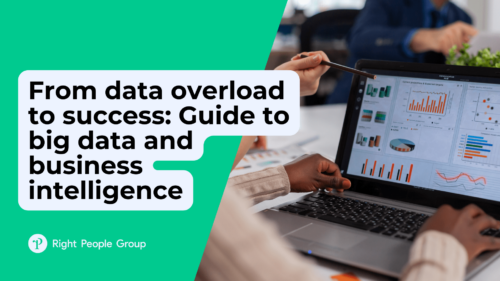In today’s digital age, businesses need data to make informed decisions and grow. But with so much data available, it can be challenging to figure out the best way to analyze it.
Business intelligence and data analytics are two approaches that help businesses make sense of their data. But what’s the difference between the two, and how do you choose the right one for your organization? In this blog post, we’ll explore these questions and provide guidance on selecting the right analytics strategy for your business.
Understanding business intelligence (BI)
Business intelligence (BI) is a technology-driven process that involves converting raw data into meaningful insights to support business operations and decision-making. BI tools typically focus on historical data, providing insights into past performance and trends.
Key Components of BI:
Data Warehousing: The process of collecting and storing data from various sources in a centralized location.
Reporting Tools: Software that extracts data from data warehouses and generates reports to help users identify trends and patterns.
Dashboard Visualization: Interactive displays that allow users to see trends and KPIs in real-time.
Key Performance Indicators (KPIs): Metrics used to evaluate the success of business operations.
Benefits of BI:
Informed Decision-Making: BI platforms help business users visualize and understand past data to make informed decisions.
Identifying Trends and Patterns: BI tools can help businesses identify patterns and trends in data that would be difficult to detect otherwise.
Enhancing Efficiency and Productivity: BI tools can help businesses optimize their operations, resulting in increased efficiency and productivity.
By leveraging business intelligence platforms, businesses can gain a competitive advantage and drive growth and success.
Let us help you find the perfect Business Intelligence consultant tailored to your needs. Contact us today.
Exploring data analytics
Data analytics involves a more in-depth analysis of data to uncover hidden patterns, correlations, and trends. Here are some key points to keep in mind when exploring data analytics:
Types of data analytics:
Descriptive Analytics: This type of analytics provides a summary of what has happened in the past. It focuses on providing insights into past performance and answering questions like “What happened?” and “Why did it happen?”
Diagnostic Analytics: This type of analytics helps to understand why something happened in the past. It focuses on identifying the root cause of a problem and answering questions like “Why did it happen?” and “What can we do to prevent it from happening again?”
Predictive Analytics: This type of analytics uses statistical models and machine learning algorithms to predict future outcomes. It focuses on answering questions like “What is likely to happen in the future?” and “What are the chances of a particular event occurring?”
Prescriptive Analytics: This type of analytics takes predictive analytics a step further by recommending actions to take based on predicted outcomes. It focuses on answering questions like “What should we do to achieve the best possible outcome?” and “What is the optimal decision to make?”
Advantages of data analytics:
Data-driven insights and decision-making: Data analytics can provide valuable insights that can guide decision-making and help organizations make data-driven decisions.
Enhanced accuracy and reduced bias: By analyzing large datasets, data analytics can help reduce the impact of human error and biases in decision-making.
Improved risk management and forecasting: Predictive analytics can help organizations anticipate future trends and identify potential risks before they occur.
Competitive advantage: By leveraging data science techniques, data analytics can help organizations stay ahead of the competition by providing insights into current performance and future trends.
Overall, data analytics can provide a more comprehensive understanding of current performance and future trends, empowering organizations to make proactive decisions and stay ahead of the competition.
Get started on finding the right Data Analyst for your business. Contact us now.
Comparing business intelligence and data analytics
While there is some overlap between business intelligence and data analytics, it’s essential to understand their key differences to choose the best approach for your organization. Here are some distinctions to consider:
Focus: Business intelligence focuses on historical data, analyzing past performance and trends to inform decision-making. In contrast, data analytics considers both current and future data, using advanced techniques to uncover hidden insights and forecast future trends.
Complexity: Business intelligence typically deals with structured data, such as sales figures, financial reports, and supply chain data. Data analytics, however, can handle unstructured and semi-structured data, including text, images, and social media content, providing a more comprehensive view of your organization’s performance.
Technology: Traditional business intelligence tools, like reporting and dashboard software, are designed to visualize and summarize past data. Data analytics business intelligence, on the other hand, leverages advanced technologies such as machine learning and artificial intelligence to mine insights from complex data sets.
Choosing the right analytics approach
When selecting between business intelligence vs data analytics, it’s crucial to consider your organization’s unique needs and goals. Here are some factors to keep in mind:
Industry and size of the organization
Your industry and the size of your business can influence the type of data you need to analyze and the insights you want to obtain.
For example, a large manufacturing company might prioritize supply chain data and use business intelligence tools to monitor KPIs, while a marketing agency may require data analysis of social media content to inform their campaigns.
Type of data available
Consider the data sources and types available within your organization.
If you primarily deal with structured data, business intelligence may be more suitable.
However, if you need to analyze unstructured or semi-structured data, data analytics might be the better option.
Desired insights and outcomes
Think about the kind of insights and outcomes you hope to achieve through your analytics efforts.
If your focus is on understanding past performance and monitoring KPIs, business intelligence tools can help.
If you’re looking to make data-driven predictions and uncover hidden trends, data analytics is likely the better choice.
Resource and capability considerations
Budget and financial considerations
Implementing advanced data analytics solutions can be more costly than traditional business intelligence tools.
Assess your budget and weigh the potential return on investment (ROI) when choosing between business intelligence vs data analytics.
Technical infrastructure
Evaluate your organization’s current technical infrastructure and its ability to support either business intelligence or data analytics tools.
Data warehouses and robust data management systems may be necessary for effective BI implementation, while data analytics often requires more advanced computing power and storage capabilities.
Available skillset and expertise
Finally, consider the skills and expertise available within your organization.
Implementing business intelligence or data analytics solutions may require hiring or training your data analyst, data scientists, or other specialized roles.
Ensure that your team has the necessary skills to effectively leverage the chosen analytics approach.

Remember that these approaches can be complementary
When deciding between business intelligence vs data analytics, remember that these approaches can be complementary in some cases. For instance, you might use BI tools to visualize historical data and monitor KPIs, while employing business analytics techniques to forecast future trends and uncover hidden insights. By aligning your analytics strategy with your organizational goals and resources, you can effectively leverage data to drive growth and stay ahead of the competition.
Conclusion
Whether you opt for business intelligence, data analytics, or a combination of both to translate your business data, ensure that your chosen strategy aligns with your organization’s needs, goals, and available resources. Continually evaluate and adjust your analytics approach as your organization evolves and grows, and you’ll be well-equipped to harness the power of data to drive success.





